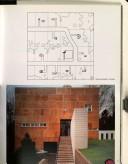
ISBN: 8425217334 9788425217333 Year: 1998 Publisher: Barcelona Editorial Gustavo Gili
Abstract | Keywords | Export | Availability | Bookmark
 Loading...
Loading...Choose an application
- Reference Manager
- EndNote
- RefWorks (Direct export to RefWorks)
This is the first monograph study of the German-born architect Simon Ungers (Cologne, 1957), who now lives and works in New York City.Simon Ungers' work can be divided into commissions, competitions and installations. The book brings together examples of all three categories, these ranging from built work such as the T-House in upstate New York to the latest schemes for international competitions, as well as a series of installations and sculptures shown in art galleries. These are different yet complementary fields of action which, taken together, offer a very complete vision of the paths and ideals in Simon Ungers' work.
architecture [discipline] --- Holocaust Memorial --- Architecture --- Ungers, Simon --- T-House --- anno 1900-1999 --- United States --- Architects --- Architecture, Modern --- Architectes --- Ungers, Simon, --- History --- Critique et interprétation --- Critique et interprétation --- museumarchitectuur --- United States of America
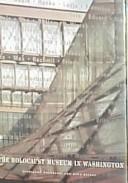
ISBN: 084781906X 0847819078 Year: 1995 Publisher: New York Rizzoli
Abstract | Keywords | Export | Availability | Bookmark
 Loading...
Loading...Choose an application
- Reference Manager
- EndNote
- RefWorks (Direct export to RefWorks)
History --- Architecture --- holocaust --- Public buildings --- Religious studies --- Washington, D.C. --- 866 Herdenking en herinnering --- Holocaust, Jewish (1939-1945) --- Catastrophe, Jewish (1939-1945) --- Destruction of the Jews (1939-1945) --- Extermination, Jewish (1939-1945) --- Holocaust, Nazi --- Ḥurban (1939-1945) --- Ḥurbn (1939-1945) --- Jewish Catastrophe (1939-1945) --- Jewish Holocaust (1939-1945) --- Jews --- Nazi Holocaust --- Nazi persecution of Jews --- Shoʾah (1939-1945) --- Genocide --- World War, 1939-1945 --- Kindertransports (Rescue operations) --- Museums --- Nazi persecution --- Persecutions --- Atrocities --- Jewish resistance --- United States Holocaust Memorial Museum. --- U.S. Holocaust Memorial Museum --- US Holocaust Memorial Museum --- Holocaust Museum (United States) --- USHMM --- Мемориальный музей Холокоста США --- Memorialʹnyĭ muzeĭ Kholokosta SShA --- U.S. Holocaust Memorial Museum, Washington --- Holocaust [Jewish ] (1939-1945) --- Washington (D.C.) --- Jewish religion --- Holocaust, Nazi (Jewish Holocaust) --- Nazi Holocaust (Jewish Holocaust) --- Nazi persecution (1939-1945) --- museumarchitectuur
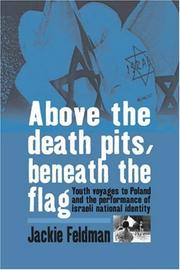
ISBN: 1282626590 9786612626593 0857450077 184545362X 184545569X Year: 2008 Publisher: New York Berghahn Books
Abstract | Keywords | Export | Availability | Bookmark
 Loading...
Loading...Choose an application
- Reference Manager
- EndNote
- RefWorks (Direct export to RefWorks)
Israeli youth voyages to Poland are one of the most popular and influential forms of transmission of Holocaust memory in Israeli society. Through intensive participant observation, group discussions, student diaries, and questionnaires, the author demonstrates how the State shapes Poland into a living deathscape of Diaspora Jewry. In the course of the voyage, students undergo a rite de passage, in which they are transformed into victims, victorious survivors, and finally witnesses of the witnesses. By viewing, touching, and smelling Holocaust-period ruins and remains, by accompanying the survi
Jews --- Israelis --- Holocaust, Jewish (1939-1945) --- Memory --- Holocaust memorial tours --- Identity. --- Travel --- Influence. --- Social aspects. --- Memorial tours, Holocaust --- Tourism --- Retention (Psychology) --- Intellect --- Psychology --- Thought and thinking --- Comprehension --- Executive functions (Neuropsychology) --- Mnemonics --- Perseveration (Psychology) --- Reproduction (Psychology) --- Ethnology
Book
ISBN: 0253002028 0253355990 9780253002020 Year: 2012 Publisher: Bloomington : Indiana University Press,
Abstract | Keywords | Export | Availability | Bookmark
 Loading...
Loading...Choose an application
- Reference Manager
- EndNote
- RefWorks (Direct export to RefWorks)
This volume offers a comprehensive account of how the Nazis conducted the Holocaust throughout the scattered towns and villages of Poland and the Soviet Union. It covers more than 1,150 sites, including both open and closed ghettos. Regional essays outline the patterns of ghettoization in 19 German administrative regions. Each entry discusses key events in the history of the ghetto; living and working conditions; activities of the Jewish Councils; Jewish responses to persecution; demographic changes; and details of the ghetto's liquidation. Personal testimonies help convey the character of
Concentration camps --- Jewish ghettos --- World War, 1939-1945 --- Campos de concentración --- Guerra, 1939-1945 (Mundial, 2a) --- Segregación --- Holocausto judío (1939-1945) --- Judíos --- Discriminación --- Derechos humanos (Derecho internacional) --- Jews --- Historia --- Campos de concentración --- Territorios ocupados --- United States Holocaust Memorial Museum --- Europa --- Alemania --- Política y gobierno --- European War, 1939-1945 --- Second World War, 1939-1945 --- World War 2, 1939-1945 --- World War II, 1939-1945 --- World War Two, 1939-1945 --- WW II (World War, 1939-1945) --- WWII (World War, 1939-1945) --- History, Modern --- Ghettos, Jewish --- Cities and towns --- Death camps --- Detention camps --- Extermination camps --- Internment camps --- Detention of persons --- Military camps --- Segregation --- U.S. Holocaust Memorial Museum --- US Holocaust Memorial Museum --- Holocaust Museum (United States) --- USHMM --- Мемориальный музей Холокоста США --- Memorialʹnyĭ muzeĭ Kholokosta SShA --- Nazi Concentration camps --- Concentration camps, Nazi --- Death camps, Nazi --- Extermination camps, Nazi --- Nazi death camps --- Nazi extermination camps --- Nazi concentration camps --- Holocaust, Jewish (1939-1945) --- History --- Government policy
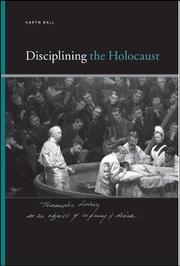
ISBN: 0791477770 1435694546 9781435694545 9780791477779 0791475417 9780791475416 9780791477779 0791475425 Year: 2008 Publisher: Albany : SUNY Press,
Abstract | Keywords | Export | Availability | Bookmark
 Loading...
Loading...Choose an application
- Reference Manager
- EndNote
- RefWorks (Direct export to RefWorks)
Disciplining the Holocaust examines critics' efforts to defend a rigorous and morally appropriate image of the Holocaust. Rather than limiting herself to polemics about the "proper" approach to traumatic history, Karyn Ball explores recent trends in intellectual history that govern a contemporary ethics of scholarship about the Holocaust. She examines the scholarly reception of Goldhagen's Hitler's Willing Executioners, the debates culminating in Eisenman's Memorial to the Murdered Jews of Europe in Berlin, Lyotard's response to negations of testimony about the gas chambers, psychoanalytically informed frameworks for the critical study of traumatic history, and a conference on feminist approaches to the Holocaust and genocide. Ball's book bridges the gap between psychoanalysis and Foucault's understanding of disciplinary power in order to highlight the social implications of traumatic history.
Psychoanalysis and culture. --- Holocaust memorials. --- Denkmal für die ermordeten Juden Europas (Berlin, Germany) --- Holocaust, Jewish (1939-1945) --- Culture and psychoanalysis --- Culture --- Memorials --- Holocaust-Mahnmal (Berlin, Germany) --- Holocaust Memorial (Berlin, Germany) --- Memorial to the Murdered Jews of Europe (Berlin, Germany) --- Stelenfeld (Berlin, Germany) --- Holocaust memorials --- Influence. --- Historiography. --- Denkmal für die ermordeten Juden Europas (Berlin, Germany). --- Denkmal fur die ermordeten Juden Europas (Berlin, Germany)
Book
ISBN: 0674989929 0674989910 9780674989917 9780674737624 0674737628 9780674989924 Year: 2021 Publisher: Purdue University Press
Abstract | Keywords | Export | Availability | Bookmark
 Loading...
Loading...Choose an application
- Reference Manager
- EndNote
- RefWorks (Direct export to RefWorks)
How did a Jewish state come to resonate profoundly with Americans in the twentieth century? Since WWII, Israel's identity has been entangled with America's belief in its own exceptionalism. Turning a critical eye on the two nations' turbulent history together, Amy Kaplan unearths the roots of controversies that may well divide them in the future.
National characteristics, American. --- Israel --- United States --- Foreign public opinion, American. --- Foreign relations --- ADL. --- AIPAC. --- Anglo-American Committee of Inquiry. --- Anti-Defamation League of B'nai B'rith. --- Anti-Semitism. --- Arafat. --- Carter. --- Elie Wiesel. --- Exodus. --- Holocaust Memorial. --- Holocaust. --- I. F. Stone. --- Intifada. --- Lebanon. --- Menachem Begin. --- Nazism. --- Richard Crossman. --- Zionism. --- al-Qaeda.
Book
ISBN: 0253008867 025300893X 9780253008930 1299706436 9781299706439 9780253008800 0253008808 9780253008862 Year: 2013 Publisher: Bloomington, Ind. : Indiana University Press,
Abstract | Keywords | Export | Availability | Bookmark
 Loading...
Loading...Choose an application
- Reference Manager
- EndNote
- RefWorks (Direct export to RefWorks)
Since the end of Communism, Jews from around the world have visited Poland to tour Holocaust-related sites. A few venture further, seeking to learn about their own Polish roots and connect with contemporary Poles. For their part, a growing number of Poles are fascinated by all things Jewish. Erica T. Lehrer explores the intersection of Polish and Jewish memory projects in the historically Jewish neighborhood of Kazimierz in Krakow. Her own journey becomes part of the story as she demonstrates that Jews and Poles use spaces, institutions, interpersonal exchanges, and cultural representations
Collective memory --- Jews --- Hebrews --- Israelites --- Jewish people --- Jewry --- Judaic people --- Judaists --- Ethnology --- Religious adherents --- Semites --- Judaism --- Collective remembrance --- Common memory --- Cultural memory --- Emblematic memory --- Historical memory --- National memory --- Public memory --- Social memory --- Memory --- Social psychology --- Group identity --- National characteristics --- History. --- History --- Poland --- Kazimierz (Kraków, Poland) --- Kazimierz Górny, Poland --- Kazimierz Górny (Poland) --- Ḳaz'imaiz (Poland) --- Ethnic relations. --- Jewish diaspora. --- Holocaust memorial tours --- Memorial tours, Holocaust --- Tourism --- Diaspora, Jewish --- Galuth --- Human geography --- Diaspora --- Migrations
Multi
ISBN: 9780813565255 9780813563244 0813565251 0813563240 9780813563237 0813563232 Year: 2014 Publisher: New Brunswick, New Jersey : Rutgers University Press,
Abstract | Keywords | Export | Availability | Bookmark
 Loading...
Loading...Choose an application
- Reference Manager
- EndNote
- RefWorks (Direct export to RefWorks)
Holocaust memorials and museums face a difficult task as their staffs strive to commemorate and document horror. On the one hand, the events museums represent are beyond most people's experiences. At the same time they are often portrayed by theologians, artists, and philosophers in ways that are already known by the public. Museum administrators and curators have the challenging role of finding a creative way to present Holocaust exhibits to avoid clichéd or dehumanizing portrayals of victims and their suffering. In Holocaust Memory Reframed, Jennifer Hansen-Glucklich examines representations in three museums: Israel's Yad Vashem in Jerusalem, Germany's Jewish Museum in Berlin, and the United States Holocaust Memorial Museum in Washington, D.C. She describes a variety of visually striking media, including architecture, photography exhibits, artifact displays, and video installations in order to explain the aesthetic techniques that the museums employ. As she interprets the exhibits, Hansen-Glucklich clarifies how museums communicate Holocaust narratives within the historical and cultural contexts specific to Germany, Israel, and the United States. In Yad Vashem, architect Moshe Safdie developed a narrative suited for Israel, rooted in a redemptive, Zionist story of homecoming to a place of mythic geography and renewal, in contrast to death and suffering in exile. In the Jewish Museum in Berlin, Daniel Libeskind's architecture, broken lines, and voids emphasize absence. Here exhibits communicate a conflicted ideology, torn between the loss of a Jewish past and the country's current multicultural ethos. The United States Holocaust Memorial Museum presents yet another lens, conveying through its exhibits a sense of sacrifice that is part of the civil values of American democracy, and trying to overcome geographic and temporal distance. One well-know example, the pile of thousands of shoes plundered from concentration camp victims encourages the visitor to bridge the gap between viewer and victim. Hansen-Glucklich explores how each museum's concept of the sacred shapes the design and choreography of visitors' experiences within museum spaces. These spaces are sites of pilgrimage that can in turn lead to rites of passage.
Art --- Holocaust, Jewish (1939-1945), and architecture --- Holocaust, Jewish (1939-1945) --- Memorialization --- Museum architecture --- Museum techniques --- Symbolism in architecture --- Museums --- Study and teaching --- Jüdisches Museum Berlin (1999- ) --- United States Holocaust Memorial Museum. --- Yad ṿa-shem, rashut ha-zikaron la-Shoʼah ṿela-gevurah. --- Museum architecture. --- Holocaust, Jewish (1939-1945), and architecture. --- Memorialization. --- Symbolism in architecture. --- Museum techniques. --- Museums. --- Study and teaching. --- Holocaust museum exhibits.
Book
ISBN: 9780813563237 9780813563244 0813563232 0813563240 0813565251 Year: 2014 Publisher: New Brunswick, New Jersey : Rutgers University Press,
Abstract | Keywords | Export | Availability | Bookmark
 Loading...
Loading...Choose an application
- Reference Manager
- EndNote
- RefWorks (Direct export to RefWorks)
Holocaust memorials and museums face a difficult task as their staffs strive to commemorate and document horror. On the one hand, the events museums represent are beyond most people's experiences. At the same time they are often portrayed by theologians, artists, and philosophers in ways that are already known by the public. Museum administrators and curators have the challenging role of finding a creative way to present Holocaust exhibits to avoid clichéd or dehumanizing portrayals of victims and their suffering. In Holocaust Memory Reframed, Jennifer Hansen-Glucklich examines representations in three museums: Israel's Yad Vashem in Jerusalem, Germany's Jewish Museum in Berlin, and the United States Holocaust Memorial Museum in Washington, D.C. She describes a variety of visually striking media, including architecture, photography exhibits, artifact displays, and video installations in order to explain the aesthetic techniques that the museums employ. As she interprets the exhibits, Hansen-Glucklich clarifies how museums communicate Holocaust narratives within the historical and cultural contexts specific to Germany, Israel, and the United States. In Yad Vashem, architect Moshe Safdie developed a narrative suited for Israel, rooted in a redemptive, Zionist story of homecoming to a place of mythic geography and renewal, in contrast to death and suffering in exile. In the Jewish Museum in Berlin, Daniel Libeskind's architecture, broken lines, and voids emphasize absence. Here exhibits communicate a conflicted ideology, torn between the loss of a Jewish past and the country's current multicultural ethos. The United States Holocaust Memorial Museum presents yet another lens, conveying through its exhibits a sense of sacrifice that is part of the civil values of American democracy, and trying to overcome geographic and temporal distance. One well-know example, the pile of thousands of shoes plundered from concentration camp victims encourages the visitor to bridge the gap between viewer and victim. Hansen-Glucklich explores how each museum's concept of the sacred shapes the design and choreography of visitors' experiences within museum spaces. These spaces are sites of pilgrimage that can in turn lead to rites of passage.
Museum architecture. --- Holocaust, Jewish (1939-1945) --- Holocaust, Jewish (1939-1945), and architecture. --- Memorialization. --- Symbolism in architecture. --- Museum techniques. --- Architecture des musées --- Holocauste, 1939-1945 --- Holocauste (1939-1945), et architecture --- Commémorations --- Symbolisme en architecture --- Muséologie --- Museums. --- Study and teaching. --- Musées --- Etude et enseignement --- Jüdisches Museum Berlin (1999- ) --- Yad va-shem, rashut ha-zikaron la-Sho'ah vela-gevurah. --- United States Holocaust Memorial Museum. --- Architecture des musées --- Commémorations --- Muséologie --- Musées --- Jüdisches Museum Berlin (1999- ) --- Yad ṿa-shem, rashut ha-zikaron la-Shoʼah ṿela-gevurah. --- Holocaust, Jewish (1939-1945), and architecture --- Memorialization --- Museum architecture --- Museum techniques --- Symbolism in architecture --- Architectural symbolism --- Signs and symbols in architecture --- Architecture --- Museology --- Museums --- Catastrophe, Jewish (1939-1945) --- Destruction of the Jews (1939-1945) --- Extermination, Jewish (1939-1945) --- Holocaust, Nazi --- Ḥurban (1939-1945) --- Ḥurbn (1939-1945) --- Jewish Catastrophe (1939-1945) --- Jewish Holocaust (1939-1945) --- Jews --- Nazi Holocaust --- Nazi persecution of Jews --- Shoʾah (1939-1945) --- Genocide --- World War, 1939-1945 --- Kindertransports (Rescue operations) --- Memorialisation --- Memorials --- Architecture and the Holocaust --- Study and teaching --- Technique --- Nazi persecution --- Persecutions --- Atrocities --- Jewish resistance --- U.S. Holocaust Memorial Museum --- US Holocaust Memorial Museum --- Holocaust Museum (United States) --- USHMM --- Мемориальный музей Холокоста США --- Memorialʹnyĭ muzeĭ Kholokosta SShA --- Jewish Museum Berlin (1999- ) --- Stiftung Jüdisches Museum Berlin (1999- ) --- Jüdisches Museum im Berlin Museum --- יד ושם, רשות הזיכרון לשואה ולגבורה. --- Yad Vashem Holocaust History Museum --- Holocaust History Museum at Yad Vashem --- Applied museology --- Museography --- Museum practices --- Museum studies --- Holocaust, Nazi (Jewish Holocaust) --- Nazi Holocaust (Jewish Holocaust) --- Nazi persecution (1939-1945) --- Holocaust museum exhibits.
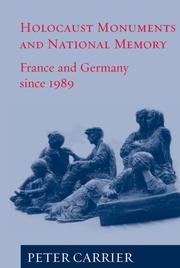
ISBN: 1571819045 184545295X 9781571819048 157181295X 178238961X 9781845452957 9781782389613 Year: 2005 Publisher: New York, [New York] ; Oxford, [England] : Berghahn Books,
Abstract | Keywords | Export | Availability | Bookmark
 Loading...
Loading...Choose an application
- Reference Manager
- EndNote
- RefWorks (Direct export to RefWorks)
Since 1989, two sites of memory with respect to the deportation and persecution of Jews in France and Germany during the Second World War have received intense public attention: the Vélo d'Hiver (Winter Velodrome) in Paris and the Monument for the Murdered Jews of Europe or Holocaust Monument in Berlin. Why is this so? Both monuments, the author argues, are unique in the history of memorial projects. Although they are genuine "sites of memory", neither monument celebrates history, but rather serve as platforms for the deliberation, negotiation and promotion of social consensus over the memorial status of war crimes in France and Germany. The debates over these monuments indicate that it is the communication among members of the public via the mass media, rather than qualities inherent in the sites themselves, which transformed these sites into symbols beyond traditional conceptions of heritage and patriotism.
holocaust --- Architecture --- Jewish religion --- Berlin --- Paris --- Holocaust memorials --- Holocaust, Jewish (1939-1945) --- Memory --- Influence --- Social aspects --- Vélodrome d'hiver (Paris, France) --- Denkmal für die ermordeten Juden Europas (Berlin, Germany) --- Denkmal für die ermordeten Juden Europas (Berlin, Germany) --- Holocaust memorials. --- Influence. --- Social aspects. --- Denkmal für die ermordeten Juden Europas (Berlin, Germany). --- Vélodrome d'hiver (Paris, France). --- Holocaust, Jewish (1939-1945) - Influence --- Memory - Social aspects --- Vélodrome d'hiver (Paris, France) --- Holocaust-Mahnmal (Berlin, Germany) --- Holocaust Memorial (Berlin, Germany) --- Memorial to the Murdered Jews of Europe (Berlin, Germany) --- Stelenfeld (Berlin, Germany) --- Retention (Psychology) --- Intellect --- Psychology --- Thought and thinking --- Comprehension --- Executive functions (Neuropsychology) --- Mnemonics --- Perseveration (Psychology) --- Reproduction (Psychology) --- Memorials

 Search
Search Feedback
Feedback About UniCat
About UniCat  Help
Help News
News